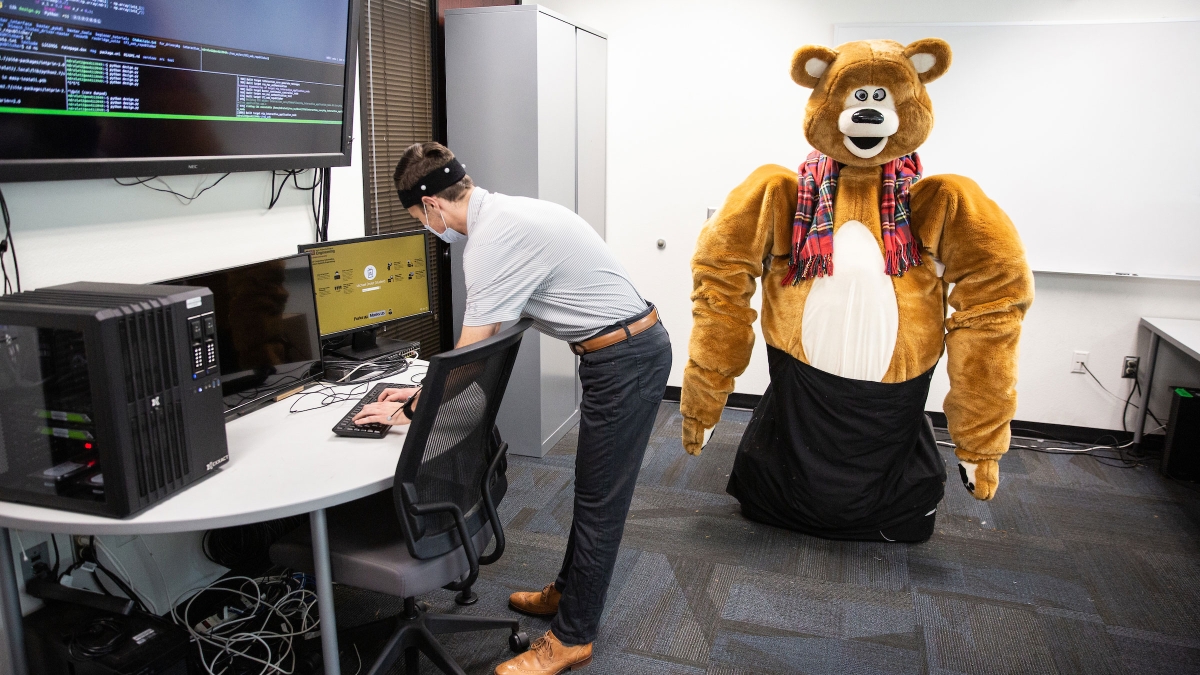Today’s robots help us perform daily tasks at home and at work, they work with medical practitioners to overcome medical challenges and physical disabilities, and now they are transporting us through our daily lives on roadways and in the air.
National Robotics Week (April 2–10) is an annual event designed to showcase what’s new in robotics and inspire students to investigate STEM-related fields.
Robotics and augmented intelligence are components of all seven of the Ira A. Fulton Schools of Engineering at Arizona State University — the largest engineering program in the country. The following are just a few examples of robotics innovation taking place at ASU.
Helper robots
Video by Ken Fagan/ASU News
Students can always find a robot hug in Assistant Professor Heni Ben Amor’s Interactive Robotics Laboratory, where the focus is on human-robot interaction, robot autonomy and machine learning. The robot is learning how to interact with humans on a one-on-one, physical basis, and perhaps teaching humans that robots can have a calming role to play, too.
Suckermouth catfish were the inspiration for the swimming robots in Assistant Professor Daniel Aukes’ IDEA Lab. The fish-inspired robot for extreme environments, or FIRE robot, can navigate through tight spaces in canals and waterways. Like the scavengers that are catfish, FIRE’s future is as a cleanup robot.
Narrow, cluttered spaces are the domain of specialized drones in Associate Professor Wenlong Zhang’s Robotics and Intelligent Systems (RISE) Lab. Able to mimic bird-like flight, these drones can squeeze their bodies to fly through narrow spaces and then expand to full flight capacity.
Auto manufacturers are moving quickly forward with autonomous technologies, and the team in Professor Aviral Shrivastava’s Make Programming Simple Lab are hastening the process. Creating a broad-based platform through which different manufacturers’ vehicles can speak with each other, humans and the environment will lead to safe, autonomous vehicle decision-making.
Assistive robots
Video by Ken Fagan/ASU News
Children with cerebral palsy and stroke victims regaining full shoulder mobility are two of the recent projects in Associate Professor Hyunglae Lee’s Neuromuscular Control and Human Robotics Lab. For the cerebral palsy platform, Lee’s team uses human-robot interaction to improve a participant’s gait – data from the unaffected leg is used to adjust the platform and improve the neuromuscular response of the impaired leg.
Shadowy robotic figures create situational awareness in Assistant Professor Yu (Tony) Zhang’s Cooperative Robotic Systems Lab. The system allows a project manager to monitor what robots are doing in the background via virtual, non-interruptive shadows. Someday, medical practitioners may have goggles to see what a robotic assistant is doing in the background.
New robotics technology for interventional radiology may soon improve procedures to insert needles, catheters and neurostimulators by using a robot arm pulling a magnet-guided device through a vascular system or tissue. The technique developed in Associate Professor Hamid Marvi’s Bio-inspired Robotics, Technology and Healthcare (BIRTH) Lab not only limits radiation exposure, but the magnetic pulling process can avoid bone obstructions or perforating an artery.
Originally designed to help U.S. Air Force aerial porters load pallets and lift cargo onto jets, Professor Thomas Sugar’s Aerial Port Exoskeleton, or APEx, will offer significant assistance to workers in a variety of industries, from warehousing to manufacturing to loading luggage on commercial flights to assisting postal workers. Created in the Human Machine Integration Lab with hip stabilizers and elements that provide robotic assistance for lifting, pushing and pulling, the device will also reduce workforce injuries.
Top photo: Computer sciences master’s degree student Michael Drolet prepares the "hugging robot" in ASU Assistant Professor Heni Ben Amor’s Interactive Robotics Laboratory on Oct. 23, 2020. Ben Amor’s lab work focuses on machine learning, human-robot interaction, grasping manipulation and robot autonomy with the hugging robot "learning" to interact with humans. Photo by Deanna Dent/ASU News
More Science and technology

Cosmic clues: Metal-poor regions unveil potential method for galaxy growth
For decades, astronomers have analyzed data from space and ground telescopes to learn more about galaxies in the universe. Understanding how galaxies behave in metal-poor regions could play a crucial…

Indigenous geneticists build unprecedented research community at ASU
When Krystal Tsosie (Diné) was an undergraduate at Arizona State University, there were no Indigenous faculty she could look to in any science department. In 2022, after getting her PhD in genomics…

Pioneering professor of cultural evolution pens essays for leading academic journals
When Robert Boyd wrote his 1985 book “Culture and the Evolutionary Process,” cultural evolution was not considered a true scientific topic. But over the past half-century, human culture and cultural…
